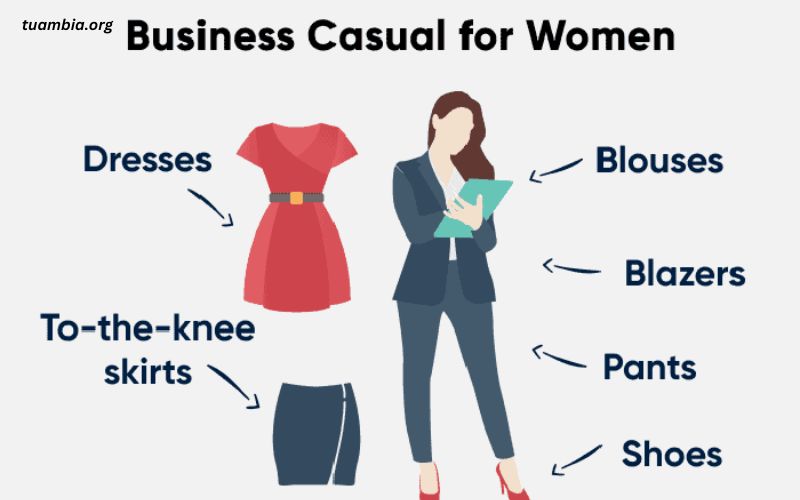In the ever-evolving world of workplace fashion, the concept of “business casual” has become a widely accepted dress code. This relaxed yet professional style strikes a balance between formality and comfort, offering a refreshing alternative to traditional corporate attire. For women, navigating the nuances of business casual can be both liberating and challenging. This article aims to demystify the concept, providing you with a comprehensive guide to mastering the art of business casual dressing.
Business casual attire emerged as a response to the changing dynamics of the modern workplace. As companies sought to foster a more inclusive and relaxed work environment, the rigid rules of formal business attire began to loosen. This shift not only reflected the evolving corporate culture but also acknowledged the need for practicality and comfort in today’s fast-paced work environments.
By understanding the principles of business casual dressing, you can curate a wardrobe that exudes professionalism while allowing you to express your personal style. This guide will explore the history and evolution of business casual for women, define its parameters, and provide practical tips for creating stylish and appropriate outfits for various workplaces.
The history and evolution of business casual for women
The concept of business casual attire can be traced back to the late 20th century when corporate America began to embrace a more relaxed approach to workplace attire. Initially, the term was introduced as a way to allow employees to dress more casually on specific days, often referred to as “Casual Fridays.”
However, as the workforce became increasingly diverse and inclusive, the demand for a more flexible and comfortable dress code grew. Companies recognized that fostering a positive work environment and promoting employee satisfaction could lead to increased productivity and retention.
For women, the evolution of business casual attire has been particularly significant. Traditionally, women’s workwear was heavily influenced by men’s attire, with suits, blazers, and formal separates being the norm. As the business casual trend gained traction, women were granted greater freedom to incorporate elements of their personal style into their professional wardrobes.
Today, business casual for women encompasses a wide range of options, from tailored dresses and blouses to sophisticated pants and skirts. This versatility allows women to express their individuality while adhering to the professional standards of their workplace.
Understanding the dress code: What does business casual mean?
While the term “business casual” is widely used, its definition can vary depending on the industry, company culture, and geographic location. Generally, business casual attire falls somewhere between formal business attire and casual weekend wear.
At its core, business casual attire should convey a polished and professional appearance while allowing for a degree of comfort and personal expression. It typically involves a combination of tailored pieces, such as dress pants, skirts, blouses, and dresses, paired with appropriate accessories.
It’s essential to note that business casual does not equate to overly casual or sloppy attire. Clothing items like jeans, t-shirts, athletic wear, and flip-flops are typically considered too casual for most business casual environments.
To ensure you’re dressing appropriately, it’s always a good idea to familiarize yourself with your company’s specific dress code guidelines or seek clarification from human resources or your manager.
Key elements of a business casual wardrobe for women
Building a versatile and stylish business casual wardrobe requires a strategic approach. By incorporating the following key elements, you can create a range of professional and polished outfits that seamlessly transition from the office to after-work events.
- Tailored Separates: Invest in well-fitting dress pants, skirts, and blazers in neutral colors like black, navy, and gray. These pieces form the foundation of a business casual wardrobe and can be mixed and matched to create various looks.
- Blouses and Tops: Opt for blouses and tops in solid colors or subtle patterns. Look for fabrics like silk, chiffon, or cotton that drape well and provide a polished appearance. Collared shirts, button-downs, and shells are excellent choices for a business casual setting.
- Dresses: Dresses can be a versatile and stylish option for business casual attire. Choose knee-length or midi dresses in classic cuts and fabrics like sheath dresses, wrap dresses, or shift dresses. Pair them with a blazer or cardigan for a more professional look.
- Sweaters and Cardigans: Layering pieces like sweaters and cardigans can add warmth and sophistication to your business casual outfits. Look for well-fitting, tailored options in neutral or muted colors.
- Accessories: Accessories can elevate your business casual look and allow you to express your personal style. Consider incorporating belts, scarves, statement jewelry, and stylish handbags or totes.
- Footwear: Opt for closed-toe shoes like pumps, loafers, or ankle boots in classic styles and colors. Avoid overly casual options like flip-flops or athletic sneakers.
By combining these elements, you can create a versatile and polished business casual wardrobe that reflects your personal style while adhering to professional standards.
Tops and blouses for a business casual look
Tops and blouses are essential components of a business casual wardrobe, as they can set the tone for your entire outfit. When selecting tops for a business casual look, consider the following options:
- Button-down Shirts: A classic button-down shirt in a solid color or subtle pattern is a timeless choice for business casual attire. Look for well-fitted shirts in fabrics like cotton or silk that can be tucked in or worn untucked.
- Blouses: Blouses offer a more feminine and polished alternative to traditional button-down shirts. Opt for blouses in fabrics like chiffon, silk, or polyester that drape elegantly. Look for styles with details like ruffles, bows, or subtle embellishments to add visual interest.
- Shells and Camisoles: Layering shells or camisoles under blazers or cardigans can create a sleek and professional look. Choose solid colors or subtle patterns in fabrics like cotton or modal for breathability and comfort.
- Sweaters: Lightweight sweaters or sweater sets can be a stylish and cozy option for cooler months. Look for fine-gauge knits in classic colors or patterns that can be easily dressed up or down.
- Printed Tops: While solid colors are always a safe choice, you can incorporate printed tops into your business casual wardrobe. Look for subtle patterns like stripes, polka dots, or floral prints in muted colors that maintain a professional appearance.
When selecting tops and blouses for business casual attire, consider the fit, fabric, and level of formality required for your workplace. Opt for well-fitting pieces that flatter your figure and maintain a polished appearance throughout the day.
Bottoms and skirts for business casual attire
Choosing the right bottoms and skirts is crucial for creating a cohesive and professional business casual look. Here are some options to consider:
- Dress Pants: Tailored dress pants in fabrics like wool, cotton, or polyester blends are a staple in any business casual wardrobe. Look for styles with a straight or slim-fit leg that flatters your figure. Opt for neutral colors like black, gray, or navy for versatility.
- Chinos or Khakis: Chinos or khaki pants can be a comfortable and stylish alternative to traditional dress pants. Choose well-fitted styles in colors like beige, olive, or navy to pair with blouses or sweaters.
- Pencil Skirts: A classic pencil skirt in a knee-length or midi silhouette can add sophistication to your business casual outfits. Look for skirts in fabrics like wool, cotton, or polyester blends in neutral colors or subtle patterns.
- A-line Skirts: A-line skirts offer a flattering and feminine silhouette that can be dressed up or down for business casual occasions. Opt for knee-length or midi styles in fabrics like cotton, linen, or lightweight wool.
- Midi Skirts: Midi skirts, which fall below the knee but above the ankle, can be a versatile and modern choice for business casual attire. Look for styles in fabrics like denim, cotton, or lightweight knits that can be paired with blouses or sweaters.
When selecting bottoms and skirts, consider the level of formality required in your workplace. Darker colors and more tailored styles may be more appropriate for more formal business casual environments, while lighter colors and relaxed fits may be suitable for more casual workplaces.
Dresses as a versatile option for business casual outfits
Dresses can be a stylish and effortless choice for business casual attire, offering both comfort and versatility. When selecting dresses for a business casual look, consider the following options:
- Sheath Dresses: A classic sheath dress in a knee-length or midi silhouette is a timeless choice for business casual attire. Look for dresses in fabrics like ponte knit, cotton, or polyester blends that offer a flattering and structured fit.
- Wrap Dresses: Wrap dresses are a popular option for business casual attire as they offer a feminine and flattering silhouette. Choose knee-length or midi styles in fabrics like jersey or lightweight knits for a comfortable and polished look.
- Shift Dresses: Shift dresses provide a relaxed and comfortable fit while still maintaining a professional appearance. Look for knee-length or midi styles in fabrics like cotton, linen, or lightweight wool.
- Fit-and-Flare Dresses: Fit-and-flare dresses offer a flattering silhouette with a fitted bodice and flared skirt. Choose knee-length or midi styles in fabrics like ponte knit or cotton for a polished and feminine look.
- Shirt Dresses: Shirt dresses, which mimic the style of a classic button-down shirt, can be a versatile and stylish option for business casual attire. Look for knee-length or midi styles in fabrics like cotton or linen for a crisp and polished appearance.
When selecting dresses for business casual attire, consider the level of formality required in your workplace. Dresses in darker colors or more structured fabrics may be more appropriate for more formal business casual environments, while lighter colors and relaxed fits may be suitable for more casual workplaces.
Shoes and accessories for completing a business casual look
While the clothing pieces are the foundation of a business casual outfit, the right shoes and accessories can elevate your look and add a touch of personal style. Consider the following options:
Shoes
- Pumps: A classic pair of closed-toe pumps in neutral colors like black, nude, or navy can instantly elevate a business casual outfit. Look for comfortable heel heights and quality materials like leather or suede.
- Loafers: Loafers offer a polished and comfortable alternative to pumps. Choose sleek styles in leather or suede for a sophisticated business casual look.
- Ankle Boots: Ankle boots can add a touch of edge to a business casual outfit while still maintaining a professional appearance. Opt for low-heeled styles in leather or suede for a versatile and stylish option.
- Flats: For a more casual business casual look, consider well-made flats in styles like ballet flats, loafers, or oxfords. Look for quality materials like leather or suede for a polished finish.
Accessories
- Blazers and Cardigans: A tailored blazer or cardigan can instantly elevate a business casual outfit, adding structure and sophistication. Choose neutral colors like black, navy, or gray for versatility.
- Belts: A well-chosen belt can cinch your waist and add definition to your outfit. Look for belts in classic colors like black, brown, or tan that complement your shoes.
- Scarves: A silk scarf or lightweight shawl can add a touch of color and pattern to a business casual outfit while also serving a practical purpose.
- Jewelry: Accessorize with classic jewelry pieces like stud earrings, a simple necklace, or a bracelet. Avoid overly chunky or flashy pieces that may appear too casual.
- Handbags: A structured handbag or tote in a neutral color like black, brown, or tan can complete your business casual look while providing functionality.
Remember, the key to accessorizing for business casual attire is to strike a balance between professionalism and personal style. Choose quality pieces that complement your outfit without overwhelming it.
Tips for putting together stylish and professional business casual outfits
Mastering the art of business casual dressing requires a combination of practical considerations and personal style. Here are some tips to help you put together stylish and professional business casual outfits:
- Understand Your Workplace Culture: Before assembling your business casual wardrobe, take the time to observe the dress code and culture within your workplace. Pay attention to what your colleagues and superiors wear to ensure your outfits align with the expected level of formality.
- Focus on Fit: Well-fitting clothing is essential for a polished and professional business casual look. Invest in tailored pieces that flatter your body shape and ensure a comfortable yet structured fit.
- Mix and Match Separates: Building a versatile wardrobe of separates allows you to mix and match pieces to create a variety of outfits. Experiment with different combinations of tops, bottoms, and layering pieces to keep your looks fresh and interesting.
- Incorporate Patterns and Prints: While solid colors are a safe choice, don’t be afraid to incorporate subtle patterns and prints into your business casual wardrobe. Look for small-scale prints or classic patterns like stripes or polka dots to add visual interest without appearing overly casual.
- Layer for Versatility: Layering pieces like blazers, cardigans, and scarves can not only add depth to your outfits but also provide versatility. You can easily adjust your look by adding or removing layers based on the occasion or temperature.
- Pay Attention to Fabrics: The fabrics you choose can significantly impact the overall look and feel of your business casual outfits. Opt for fabrics like cotton, linen, wool, or silk blends that drape well and maintain a polished appearance.
- Accessorize Thoughtfully: Accessories can elevate your business casual look and allow you to express your personal style. Choose quality pieces like leather handbags, classic jewelry, and well-made shoes to add a touch of sophistication.
- Consider Your Grooming: Proper grooming is an essential aspect of a polished business casual appearance. Ensure your hair is neatly styled, makeup is minimal and professional, and nails are well-groomed.
Remember, the key to mastering business casual attire is finding the right balance between professionalism and personal style. Don’t be afraid to experiment and have fun with your outfits while maintaining a level of sophistication appropriate for your workplace.
Adapting business casual attire for different industries and workplaces
While the general principles of business casual attire remain consistent, it’s essential to recognize that different industries and workplaces may have varying expectations and dress code guidelines. Here are some tips for adapting your business casual wardrobe to suit different professional environments:
- Corporate and Finance: In more traditional corporate and finance industries, business casual attire tends to lean towards a more conservative and polished aesthetic. Opt for tailored separates like blazers, dress pants, and button-down shirts in neutral colors. Accessorize with classic pieces like leather bags and closed-toe pumps.
- Creative and Tech Industries: In creative and tech-focused workplaces, business casual attire often allows for more flexibility and self-expression. You can incorporate trendier pieces like patterned dresses, colored chinos, or statement accessories while maintaining a polished overall look.
- Casual Office Environments: Some workplaces, particularly in the tech or startup sectors, may embrace a more relaxed interpretation of business casual attire. In these environments, you may be able to incorporate well-fitted jeans (without rips or distressing), casual tops, and sneakers or loafers.
- Client-Facing Roles: If your role involves frequent client interactions or meetings, it’s advisable to err on the side of a more polished and formal business casual look. Consider tailored dresses, blazers, and closed-toe shoes to project a professional image.
- Outdoor or Field Work: For industries that involve outdoor or field work, business casual attire may need to be adapted for practicality and safety. Look for comfortable yet stylish options like khakis, polo shirts, and sturdy shoes that allow for mobility and protection.
- Healthcare and Medical Fields: In healthcare and medical settings, business casual attire should prioritize professionalism and hygiene. Consider wearing scrubs or tailored separates in muted colors, paired with comfortable closed-toe shoes and minimal jewelry.
Remember, it’s always a good idea to familiarize yourself with your company’s specific dress code guidelines or consult with your manager or human resources department to ensure you’re adhering to the expected standards.
Common mistakes to avoid when dressing in business casual attire
While business casual attire offers more flexibility than formal business attire, there are still some common mistakes to avoid to maintain a professional and polished appearance:
- Overly Casual or Sloppy Clothing: Women dressing as if you’re running errands or lounging at home. Avoid clothing items that are too casual, such as ripped or distressed jeans, athletic wear, flip-flops, or overly revealing tops.
- Ill-Fitting Garments: Poorly fitted clothing can detract from a polished business casual look. Ensure your garments are tailored to flatter your figure and provide a comfortable yet structured fit.
- Excessive Patterns or Prints: While patterns and prints can add visual interest to your outfits, it’s essential to exercise moderation. Avoid wearing multiple bold patterns or prints together, as it can appear overwhelming and unprofessional.
- Inappropriate Footwear: Footwear plays a crucial role in completing a business casual look. Avoid wearing overly casual options like flip-flops, athletic sneakers, or shoes in disrepair.
- Neglecting Grooming and Hygiene: Even with a well-curated business casual wardrobe, neglecting grooming and hygiene can undermine your professional appearance. Ensure your hair is neatly styled, makeup is minimal and appropriate, and nails are well-groomed.
- Overdoing Accessories: While accessories can add personality to your outfits, it’s important to strike a balance. Avoid wearing too many statement pieces or jewelry that may appear distracting or unprofessional.
- Wearing Clothing with Offensive or Inappropriate Graphics or Messages: Business casual attire should remain respectful and professional. Avoid wearing clothing with offensive graphics, slogans, or messages that could be deemed inappropriate in a workplace setting.
By being mindful of these common mistakes, you can ensure that your business casual attire exudes professionalism and sophistication while still allowing for personal expression.
FAQs about business casual for women
As you navigate the world of business casual attire, you may have some frequently asked questions. Here are some common queries and their answers:
- Can I wear jeans in a business casual setting? The appropriateness of wearing jeans in a business casual setting can vary depending on the workplace culture and industry. In some casual office environments, well-fitted, dark-wash jeans without rips or distressing may be acceptable. However, in more traditional or formal workplaces, it’s generally advisable to opt for dress pants or skirts instead.
- Are open-toe shoes appropriate for business casual attire? Open-toe shoes, such as sandals or peep-toe pumps, can be appropriate for business casual attire in warmer months or more casual office environments. However, in more formal or corporate settings, it’s generally recommended to stick with closed-toe shoes for a more polished look.
- Can I wear a sleeveless top or dress in a business casual setting? Sleeveless tops or dresses can be acceptable in business casual settings, provided they are tailored and not overly revealing. Consider layering with a blazer or cardigan for a more professional look, especially in more formal environments or client-facing roles.
- How casual is too casual for business casual attire? The line between casual and too casual can be subjective, but a good rule of thumb is to avoid clothing items that are typically reserved for lounging or athletic activities, such as sweatpants, leggings, tank tops, or athletic sneakers. Prioritize well-fitted, tailored pieces that maintain a polished and professional appearance.
- Can I wear the same business casual outfit multiple times in a week? While it’s generally acceptable to repeat outfits in a business casual setting, it’s advisable to mix and match different pieces to create variety in your looks. Consider rotating your tops, bottoms, and layering pieces to avoid appearing as if you’re wearing the exact same outfit multiple times in a short period.
- How do I accessorize for a business casual look? When accessorizing for business casual attire, opt for classic and understated pieces that complement your outfit without overwhelming it. Consider adding a tailored blazer, a simple scarf, or a structured handbag. Avoid overly chunky or flashy jewelry that may appear too casual.
Remember, the key to mastering business casual attire is finding the right balance between professionalism and personal style while adhering to your workplace’s specific dress code guidelines.
Conclusion: Embracing confidence and personal style in business casual attire
Navigating the world of business casual attire can be both exciting and challenging for women. It offers the opportunity to express your personal style while maintaining a professional and polished appearance in the workplace.
By understanding the key elements of a business casual wardrobe, such as tailored separates, versatile dresses, and appropriate footwear and accessories, you can curate a collection of outfits that not only reflect your individual aesthetic but also align with the expectations of your workplace.
Remember, confidence is the ultimate accessory in any outfit. Embrace your personal style, experiment with different combinations, and don’t be afraid to step outside of your comfort zone while staying within the boundaries of professional attire.
Business casual attire allows you to strike a balance between formality and self-expression, empowering you to feel comfortable and confident in your work environment. As you continue to build and refine your business casual wardrobe, remember to stay true to yourself while respecting the dress code guidelines of your workplace.
Elevate your professional image with our curated collection of stylish and versatile business casual pieces. Explore our selection today and unlock the confidence to express your personal style while maintaining a polished and sophisticated appearance in the workplace. Visit our website or stop by our boutique to discover the perfect additions to your business casual wardrobe.






